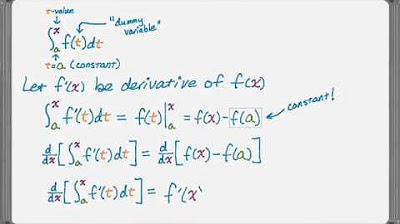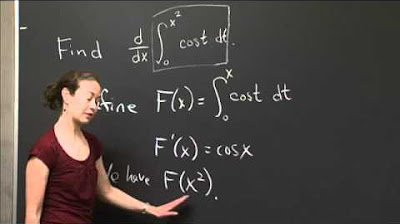Worked example: Finding derivative with fundamental theorem of calculus | Khan Academy
TLDRThe video script presents a mathematical concept involving the application of the fundamental theorem of calculus to find the derivative of a definite integral. It explains how to derive the function F(x) as the integral of cotangent squared from pi to x and then illustrates the process of finding F'(x) using the theorem. The script further explores a variation where the integral is from pi to x squared, emphasizing the use of the chain rule to find the derivative in this scenario. The explanation is clear, methodical, and tailored to engage viewers with an interest in calculus.
Takeaways
- 📚 The problem involves finding the derivative of a definite integral involving the cotangent squared function.
- 🌟 The fundamental theorem of calculus is applied to find the derivative of the capital F of x, which is the integral from pi to x of cotangent squared of t dt.
- 🔄 The derivative of F with respect to x is simply the function evaluated at x, which in this case is cotangent squared of x.
- 📈 The process can be extended to more complex integrals, such as when the limits of integration are not just x but a function of x, like x squared.
- 🔧 The chain rule is introduced to handle the derivative of the integral when the limits are functions of x, like in the case of the integral from pi to x squared.
- 🔢 The chain rule involves taking the derivative of the function inside the integral and then multiplying by the derivative of the limit function.
- 🎓 The derivative of F with respect to x squared is found by evaluating the original function at x squared, resulting in cotangent squared of x squared.
- 🚀 The final result is obtained by multiplying the derivative of the function inside the integral by the derivative of the limit function with respect to x.
- 🧠 The example serves as a lesson on the efficient use of calculus rules to solve complex problems without the need for intermediate steps like finding the antiderivative.
- 🏆 This type of problem is common in calculus competitions and exams, showcasing the importance of understanding and applying the fundamental theorem of calculus and the chain rule effectively.
Q & A
What is the main concept discussed in the transcript?
-The main concept discussed in the transcript is the application of the fundamental theorem of calculus to find the derivative of a definite integral.
What is the definite integral of cotangent squared from pi to x?
-The definite integral of cotangent squared from pi to x is represented by the function F of x, which is the antiderivative evaluated from pi to x of cotangent squared of t dt.
What is the derivative of F(x) according to the fundamental theorem of calculus?
-The derivative of F(x) is cotangent squared of x, as the fundamental theorem of calculus states that the derivative of a definite integral is the function itself without the integral bounds.
How does changing the limits of integration from x to x squared affect the problem?
-Changing the limits of integration from x to x squared modifies the function F, resulting in F of x squared. This requires the application of the chain rule to find the derivative with respect to x.
What is the expression for the derivative of the definite integral from pi to x squared of cotangent squared of t dt?
-The expression for the derivative is 2x times the cotangent squared of x squared, which is derived by applying the chain rule.
What is the role of the chain rule in this problem?
-The chain rule is used to find the derivative of the modified function F(x^2) by taking the derivative of F with respect to x squared and multiplying it by the derivative of x squared with respect to x.
How does the fundamental theorem of calculus simplify the process of finding the derivative of a definite integral?
-The fundamental theorem of calculus simplifies the process by directly stating that the derivative of a definite integral is the function that is being integrated, without the need to compute the antiderivative and evaluate it at the bounds.
What is the significance of recognizing the change from x to x squared in the integral?
-Recognizing the change from x to x squared is crucial because it indicates that the problem now involves a variable limit of integration, which requires the use of the chain rule to find the derivative correctly.
What is the derivative of cotangent squared of t with respect to x squared?
-The derivative of cotangent squared of t with respect to x squared is cotangent squared of x squared, as the derivative of the function inside the integral with variable limits follows the chain rule.
What is the derivative of x squared with respect to x?
-The derivative of x squared with respect to x is 2x, which is a basic power rule in calculus.
How can this problem be applied in real-world scenarios?
-While this specific problem may not have direct real-world applications, the concepts of the fundamental theorem of calculus and the chain rule are widely used in various fields such as physics, engineering, and economics for modeling and analyzing dynamic systems.
Outlines
📚 Application of the Fundamental Theorem of Calculus
This paragraph introduces a mathematical concept where the capital F of x is defined as the definite integral from pi to x of cotangent squared of t dt. The main focus is on finding the derivative of this function, F prime of x. By applying the fundamental theorem of calculus, it's explained that the derivative is simply the function that was integrated, but now evaluated at the variable of interest, which in this case is cotangent squared of x. The explanation emphasizes the efficiency of this method over traditional antiderivatives and evaluation at boundaries, especially relevant for calculus competitions and exams.
🔄 Variation of the Integral with a Modified Boundary: x^2
The paragraph discusses a variation of the initial integral by changing the upper limit from x to x squared. The challenge is to find the derivative of this new integral with respect to x. The explanation clarifies that the new function, F of x squared, is analogous to the original F of x, but with every instance of x replaced by x squared. To find the derivative, the chain rule is applied. The derivative of F with respect to x squared is multiplied by the derivative of x squared with respect to x. The final result is that the derivative of the integral from pi to x squared of cotangent squared of t dt is 2x times cotangent squared of x squared.
Mindmap
Keywords
💡Definite Integral
💡Cotangent Squared
💡Fundamental Theorem of Calculus
💡Derivative
💡Chain Rule
💡Function F
💡
💡Rate of Change
💡Integration
💡Trigonometric Functions
Highlights
The concept of capital F of x being equal to the definite integral from pi to x of cotangent squared of t dt is introduced.
The derivative of F with respect to x, denoted as F prime of x, is discussed using the fundamental theorem of calculus.
The fundamental theorem of calculus is applied to find that the derivative of F with respect to x is equal to cotangent squared of x.
An example problem is presented where the definite integral is from pi to x squared, instead of pi to x, involving cotangent squared of t dt.
The process of taking the derivative with respect to x of the new expression is explained, highlighting the change from x to x squared.
The chain rule is mentioned as the method to find the derivative of the new expression, F of x squared.
The derivative of F with respect to x squared is identified as the key to solving the problem.
The derivative F prime of x squared is found to be cotangent squared of x squared by evaluating F prime at x squared.
The final result of the derivative with respect to x squared is 2x cotangent squared of x squared, showcasing the application of the chain rule.
The transcript provides a straightforward and fast method for solving calculus problems involving derivatives and definite integrals.
The importance of recognizing the change in the variable of integration when applying the fundamental theorem of calculus is emphasized.
The transcript serves as a guide for those participating in calculus competitions or exams, offering a clear and efficient approach to problem-solving.
The process of replacing x with x squared in the original function to find the derivative is detailed, providing a clear step-by-step explanation.
The derivative of the entire expression with respect to x squared is calculated, demonstrating the practical application of calculus concepts.
The transcript illustrates the power of the chain rule in advanced calculus, particularly when dealing with composite functions.
The transcript's content is valuable for readers seeking to understand the relationship between derivatives and definite integrals in calculus.
The transcript's methodical approach to solving calculus problems can help readers build a strong foundation in the subject.
Transcripts
Browse More Related Video

Second Fundamental Theorem of Calculus 2nd FTC

Derivatives of Integrals (w/ Chain Rule)

Proof of fundamental theorem of calculus | AP Calculus AB | Khan Academy

Second fundamental theorem and chain rule | MIT 18.01SC Single Variable Calculus, Fall 2010

Applying the Second Fundamental Theorem | MIT 18.01SC Single Variable Calculus, Fall 2010

Finding derivative with fundamental theorem of calculus: x is on both bounds | Khan Academy
5.0 / 5 (0 votes)
Thanks for rating: